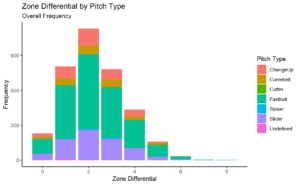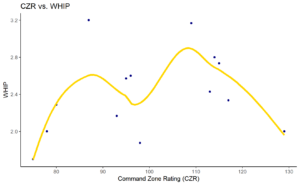Kramer’s Model for Measuring Pitcher’s Performance
Author: David Kramer
How to Measure Performance

Zone difference distributions
When measuring the performance of pitchers, baseball analysts often turn to pitch control metrics: binary measurements of pitching accuracy on the basis of a pitch being thrown inside or outside of the strike zone. While important in primary analysis, however, pitch control is rudimentary with respect to how we should evaluate overall pitch quality. The idea of pitching command— capturing a pitcher’s discipline, precision, and overall execution—aims to quantify the intentionality and design behind pitches from the mound. But without any reliable, publicly available, and actionable methods of evaluating the artful components of NCAA baseball, pitching command has not moved beyond a purely conceptual coaching tool. Most NCAA programs have accepted the limitations of data systems like TrackMan and Rapsodo as given, providing answers for strictly scientific questions. As a result, the effects of artistry in a game so profoundly shaped by it have been widely inaccessible for centuries.
Command Zone Rating Plus

Zone differential by pitch type
The artistry of college baseball deserves a better understanding among insight-driven audiences, and a new pitching command metric helps change the way that college baseball admires it. Command Zone Rating Plus (CZR+), the first automated pitching command metric in the history of NCAA baseball, provides an algorithmic tool to quantify the execution, discipline, and overall performance of collegiate rosters.
CZR+ uses an algorithmic linear combination of iterative, component-wise random forest classifications in R to quantify the “command” of collected pitches. In this solution, pitching command is expressed as a compound of two measurements:
- The magnitude of a missed pitch by way of Pythagorean distance, measured as the absolute distance between the intended pre-pitch location and the actual geospatial result of a given pitch.
- The impact that a “missed pitch” of this magnitude creates, calculated through two families of probabilistic model-building—one for balls, and one for strikes.

CZR-WHIP
As a fully automated, flexible, free, and publicly available calculation of otherwise abstract components of baseball, CZR+ stands as a monumental baseline for future research on pitching command, both at Notre Dame and beyond. Through new NCAA data architecture built in the Notre Dame Baseball organization throughout the Fighting Irish’s historic 2022 season, CZR+ provides a standardized method of performance evaluation for pitchers across the NCAA Division I landscape.
The full tool for college baseball’s first pitching command metric can be accessed on GitHub.
Ready to create your own metrics? Click here to learn more: MSBA program pages (MSBR, MSBA-C, MSBA-SA)




